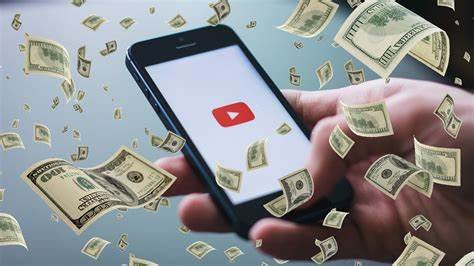If you’re a content creator on YouTube, you’ve probably wondered how to turn your passion into a source of income. Monetizing a YouTube channel involves more than just posting videos and hoping for views—it requires a strategy and understanding of various monetization options. Whether you’re just starting out or looking to maximize your earnings, here’s a step-by-step guide on how to monetize your YouTube channel and make money.
1. Enable YouTube AdSense (YouTube Partner Program)
The most common way to monetize your YouTube channel is through ads. The YouTube Partner Program (YPP) allows creators to earn revenue from ads that run on their videos. To become eligible, you need to meet the following criteria:
- 1,000 Subscribers
- 4,000 Watch Hours in the Last 12 Months
- Follow YouTube’s policies and guidelines
- Have an AdSense account
Once accepted into the YouTube Partner Program, you can enable monetization on your videos. YouTube will place ads, such as display ads, overlay ads, or skippable video ads, and share the revenue with you. The amount you earn depends on factors like ad type, viewer location, and video engagement.
- Tip: Focus on creating engaging and high-quality content to attract more viewers and increase ad revenue.
2. Earn Money Through Sponsored Content
Sponsorships are a great way to monetize your YouTube channel, especially if you have a niche audience or a decent following. Brands are willing to pay creators to feature their products or services in videos. Sponsored content can include product reviews, shoutouts, or integrated advertisements.
To attract sponsors, you’ll need to:
- Build Your Audience: Brands typically seek out creators with a loyal and engaged audience.
- Create a Media Kit: Highlight your channel’s demographics, views, and engagement rates.
- Reach Out: You can also contact potential sponsors directly, especially if you have a specific brand in mind.
Sponsored content provides you with a flat rate for a specific video or a series of videos, and the payment is usually agreed upon before you produce the content.
- Tip: Choose sponsors whose products or services align with your content and audience for more authentic partnerships.
3. Use Affiliate Marketing to Earn Commissions
Affiliate marketing allows you to earn money by promoting products or services and earning a commission on each sale made through your referral link. Many online retailers, including Amazon, offer affiliate programs that you can join.
To use affiliate marketing on YouTube:
- Choose Products Relevant to Your Audience: Only promote products your viewers would be interested in, such as camera gear, software, or tools related to your content.
- Add Affiliate Links in Video Descriptions: Include affiliate links to the products you mention in your videos, encouraging viewers to make a purchase.
- Create Review and Tutorial Videos: These types of videos work well for affiliate marketing, as viewers may trust your opinion on a product before making a purchase.
Affiliate marketing can be a passive source of income, as you earn money whenever someone makes a purchase through your link, even if they’re watching your video months after it’s been posted.
- Tip: Always disclose affiliate links to maintain transparency with your audience, as required by YouTube’s guidelines and legal regulations.
4. Offer Channel Memberships and Paid Content
Once you’ve built a substantial following, you can offer your subscribers the option to join your channel as paying members. YouTube’s “Channel Memberships” feature lets creators offer exclusive perks, such as custom badges, emojis, and access to members-only content.
To be eligible, your channel must have at least 30,000 subscribers. Once you’ve set up memberships, you can create exclusive live streams, videos, and posts for members who pay a monthly fee. This model can provide you with steady recurring income.
Additionally, YouTube allows creators to charge for individual pieces of content through Super Thanks or Super Chats (during live streams). Viewers can pay to highlight their comments during live chats, creating another stream of income.
- Tip: Offer valuable perks for your members to keep them engaged and motivated to support your channel.

5. Sell Merchandise Through YouTube’s Merch Shelf
If you have a strong brand identity or fanbase, you can monetize by selling your own merchandise directly through YouTube’s integrated Merch Shelf. This feature allows you to sell items such as T-shirts, hats, mugs, and more directly under your videos.
To access the Merch Shelf, you need to:
- Be part of the YouTube Partner Program.
- Have at least 10,000 subscribers.
- Partner with a YouTube-approved merchandise company like Teespring, Spreadshop, or Shopify.
Selling merchandise is an excellent way to connect with your audience while generating additional revenue. You can promote your merch during videos, in video descriptions, or even offer exclusive items for your subscribers.
- Tip: Ensure your merchandise reflects your brand and appeals to your viewers, such as logos, catchphrases, or inside jokes from your videos.
6. Crowdfund Your Content with Platforms like Patreon
Crowdfunding platforms like Patreon allow your fans to support you directly in exchange for exclusive content or perks. Patreon works well for creators with a dedicated following who are willing to contribute a monthly amount in exchange for rewards like early access to videos, behind-the-scenes content, and more.
- Tip: Create different membership tiers with varying levels of rewards to cater to fans with different budgets. This increases the likelihood of more people contributing.
7. Create and Sell Online Courses or E-books
If your YouTube channel focuses on education, tutorials, or a particular skill, you can create and sell your own courses or e-books. Platforms like Teachable or Udemy make it easy to create and sell your courses, while e-book platforms like Amazon Kindle Direct Publishing allow you to self-publish books.
- Tip: Use your YouTube content to promote your courses or e-books. Offer sneak peeks or free samples in your videos to entice viewers to purchase.
8. Get Donations via Super Chat or Super Stickers
If you’re live-streaming or engaging with your audience in real-time, Super Chat and Super Stickers offer a way for viewers to donate money during live streams. This feature lets viewers pay to highlight their messages or show appreciation for your content.
- Tip: Engage with viewers during live streams to encourage donations. Responding to questions or comments in real-time builds a sense of community, which can result in more donations.
Conclusion
Monetizing a YouTube channel is not an overnight process, but with consistency, creativity, and the right strategy, you can start earning money from your videos. Experiment with multiple revenue streams, such as AdSense, sponsored content, affiliate marketing, and selling merchandise, to find what works best for you. Keep engaging with your audience, stay true to your niche, and continually look for new ways to enhance your content and grow your channel.




